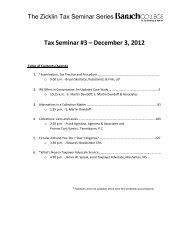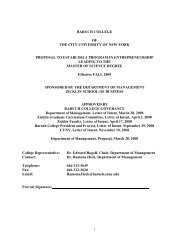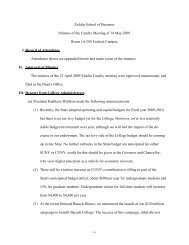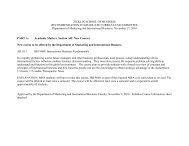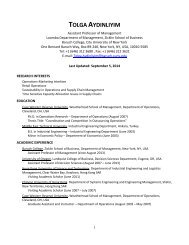alliances a strategic framework
Download - zicklin : school of business - CUNY
Download - zicklin : school of business - CUNY
- No tags were found...
Create successful ePaper yourself
Turn your PDF publications into a flip-book with our unique Google optimized e-Paper software.
MD<br />
49,8<br />
1250<br />
negotiations are likely to be most critical when the alliance has experienced or is<br />
experiencing unfavorable outcomes. The different negotiation strategies have different<br />
implications for how best the alliance partners deal with such unfavorable outcomes.<br />
Problem solving strategy<br />
A problem solving strategy with its emphasis on an equal concern for one’s own and<br />
the partner’s outcomes, will seek to deal with the negative outcomes in a calm and<br />
focused manner. Alliance firms will refrain from blaming their partners and will not<br />
confront their counterparts unless they have clear-cut evidence that their partner has<br />
been at fault. Likewise, the firm will accept responsibility for any shortcomings if it<br />
realizes that errors have been committed and maybe things could have been handled<br />
differently. This will prevent any conflict escalation and will ensure that the partner<br />
firms remain focused on the task at hand. The partners will also debate alternatives<br />
calmly and reasonably. They may or may not decide to continue with the alliance but<br />
whatever be their decision their relationship is likely to be unaffected by negative<br />
outcomes.<br />
Contending strategy<br />
A strategy of contending focuses solely on concerns with one’s own outcomes. This is<br />
also a short-term strategy where the partner firms are trying to extract the maximal<br />
advantage in an unfavorable situation. The partners will engage in a blame game and<br />
deny any responsibility for the emergence of negative outcomes in the alliance. They<br />
will attribute the negative outcomes to their counterpart. If the alliance is to be<br />
dissolved, the partners may squabble about the termination process. How will the costs<br />
be shared? Threats of legal action and inflammatory actions may very well follow. The<br />
relationship is likely to deteriorate and it is more than likely that these partners will<br />
never again enter into another alliance. They may also seek to reevaluate the viability<br />
of <strong>alliances</strong> for their company as a whole.<br />
A good example of a contending strategy is the alliance between Meiji Milk and<br />
Borden products (Cauley de la Sierra, 1995). The alliance had been in existence for<br />
some 20 years when problems erupted. The sales of Borden’s products in Japan began<br />
to slow down and Borden felt that Meiji was doing this purposefully. Borden made the<br />
public statement that Meiji Milk had set out to destroy the relationship as it was<br />
seeking to develop its own products. Shortly thereafter, Borden exited from the<br />
alliance.<br />
Yielding strategy<br />
The strategy of yielding implies lowering one’s own expectations and acceding to the<br />
demand or the requests of one’s partner. In a negative outcome context yielding could<br />
mean either agreeing with the partner to exit the alliance if requested it or alternatively<br />
to persist with the alliance if it would prefer that option. Yielding presupposes a lack of<br />
leverage or low bargaining power. However, it could also connote a good relationship<br />
with one’s partner, as this may be a compelling reason to accede to its requests. We<br />
would suppose that a strategy of yielding would be neutral in terms of strengthening<br />
or weakening the relationship with one’s partner. It is also the case that when a partner<br />
yields the interpartner negotiation process will be much less costly and time<br />
consuming.



